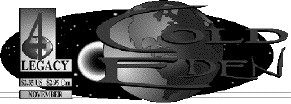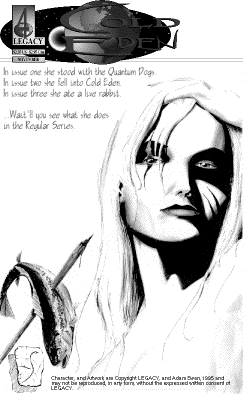In an interview explaining why he had jumped on board with Image, Jeff Smith (of Bone fame) said that he was never really part of the independent publishing scene, and that he hadn’t been encouraging people to go into comics because of the state of the industry. This, I felt, was self-centered and more than a little insulting to aspiring creators. Like acting or writing, I think comic artists are compelled to draw, and they will follow their hearts and try to do what they want with their lives. Jeff Smith must realize as well as anyone that it’s futile to try to discourage someone from trying to do what they really want to do. All Jeff was really saying is that he’s inside now and he doesn’t want anyone asking him to give them a hand getting through the door. In light of how I felt when I read that article I’ve assembled a sort of basic primer for publishing your own comic. For more specific questions, write to me, and I will post answers here, as well as directly to you.
It Begins…
The best advice I can offer is to get lots of money. Every cent you can lay your hands on. This will save time later.
Advance promote in every way you can think of. I’m sure you look at the numbers for The X-Men or Spawn and think “Hey, we don’t even need five percent of their sales to make a profit,” and that you feel your comic will attract readers on it’s own merits. This is not going to happen. You have to do everything you can to promote your book before you start publishing, because once your comic is in print, if you aren’t at least breaking even, the publishing expenses will suck money out of you so fast.
What are your goals for the publication of your comic?
- Is it in colour? Not likely, unless you have a big inheritance.
- Will it have a colour cover? The cover is the most visible thing, next to the title art.
- What level of sales are you aiming for? Don’t kid yourself.
- How will you advertise your comic?… And get your chequebook ready.
- How will you print it? Your printing is very likely going to be largely determined by your budget.
- How will you distribute it? Diamond is the only major distributor left in North-America. Heroes World was, of course bought by Marvel; Andromeda folded; Multibooks, Styx, and Capitol City are now aiming more at gaming, and comic-related merchandise.
- What kind of comic is it? You will need to project a cohesive image for your comic when you are advertising, or each ad you place will be starting from ground up in peoples minds. It is better if they take something with them from ad to ad. This is why companies have logos and trademarks. It is also the whole theory behind the marketability of superheroes.
- Is it an ongoing series? One-shot? Limited Series?
Legal and Financial Liabilities
The legal liabilities are the same as with any company, you must obtain whatever permits are required to operate a business in your city/state/province/country.
The only real legal problems you can encounter in comics have to do with copyright infringement, and theft of intellectual property. I don’t know of any cases that went anywhere however. It is almost impossible to prove that a concept is insufficiently different enough to be considered stolen. If anyone knows of any cases that had conclusive outcomes, please write to me with the details… and who knows, nowadays, you might be liable for papercuts, or if someone gets poisoned by eating your comic.
If you are going to be selling copies of your comic directly to the public (ie. they hand you money, you hand them a comic) you may be required to get a Vendors Permit. You are required to do this in Canada. You will also need a GST number if you operate in Canada, or sell to Canadian companies. Go ask Revenue Canada about this though, because I can’t explain it…
You will have to learn how, or pay someone, to file tax forms. You must keep careful records of purchases you make for the purpose of doing business, as well as travel, food, hotel stays… Many of these expenses will be tax deductible, and that could save you some serious money.
You should also learn how to keep books, tracking cashflow in and out of your accounts. If you are going for a bank loan, you should know this, and how to prepare cash-flow forecasts: most banks will want predictions of why and how you’re going to make money, as well as some reason why they should believe what you’re telling them. For learning bookeeping I suggest either a course and/or using a bookeeping program such as Quicken. Expect to spend many hours setting up your books on Quicken (10-20 hrs), and then plan on spending an hour or two a week maintaining them.
When going for a loan, shop around. In times of economic recession, banks offer special rates and terms to promote cash flow. Also, you should investigate how ‘small-business-friendly’ different banks are. There can be quite a difference.
The financial liabilities, other than those outlined in the rest of this article are mostly that you should expect to not reach break-even for months, and thus you will lose money for awhile.
…And on that note let’s talk:
Advertising
Publishing a comic will cost thousands of dollars, and advertising it will probably cost more than the actual production. There are a number of venues to advertise in, so you should become familiar with every comic related publication.
The first thing you need to decide is who you’re aiming your advertising at, and what you want to tell them. Remember, no matter how small your goals for the sales of your comic, as soon as you publish you’re stepping up to the plate to compete directly against Marvel, DC, and Image for the comic reader’s money.
Important things to look for in advertising:
- Circulation (Obviously)
- Demographics—Who reads this magazine? How old are they? Male/Female? What kind of comics do they buy? Does your comic fit their demographics?
- Cost (Again, obviously)
It is helpful, when trying to get readers attention, to have a recurring theme in your ads that they will remember from one time to the next. It also helps to have a specific message that you are trying to project, and if possible, to look different from what’s around you.
The other approach is of course to try to ride on the successful marketing of another company, or product. This is pretty obviously done an awful lot in the entertainment industry, and I must be honest; it does work a lot of the time… to some extent. But, seeing as you’re trying to publish an independent comic yourself, you’re probably all fired up with how original and ground-breaking your work is so you won’t be using this approach.
All information is accurate, to the best of my knowledge, but is in no way binding for the companies mentioned, and is intended solely as a source of information to use for the purpose of estimation. In addition, companies may be offering special ad rates, or promotions. For exact information, contact the company directly.
The Venues available, in brief:
Wizard is the largest-circulation comic-related magazine in America, with a paid circulation somewhere around 400,000 copies a month. They are also, however, a very expensive place for an independent to try to compete for attention.
- Contact: Allison James
- Full Page B&W: $4547/month for 6 months (contract)
- Circulation: 350,000+
Fan magazine has a small circulation at the moment, but it is published by Gemstone, the parent company of Diamond, America’s only real distributor at this point. It seems very likely that Fan will be growing dramatically in the coming months, particularly in light of all the exclusive contracts Diamond has signed.
- Contact: John McGonigle
- Full Page B&W: $2000, but colour is only $2500 (?)
- Circulation: Was 50,000, but has probably gone up.
The sister publication of Fan is, of course, Previews. Previews used to have a circulation of 100,000 to 125,000 per month, before the exclusive contracts. Their current circulation is anyone’s guess. Previews is not a fan-mag, it is a catalogue of Diamond-distributed products. Its ad rates are very reasonable, but all the high-visibility ad space is reserved for DC, Image, Dark Horse, Acclaim etc.
- Contact: Steve Bond
- Full Page B&W: $800
- Circulation: 100,000+
Indy Magazine is a relatively inexpensive place to advertize as they give Xeric grant winners 50% off their ads and often cut people breaks if they want to run a reciprocal ad in their comic… They are a magazine dedicated solely to the coverage of independent comics…
- Contact: Geoffrey Mason
- Full Page B&W $90
- Circulation: 4,000 for the last issue, generally increasing by 25% with each issue.
Comic Buyers Guide (CBG) is mostly read by independent comic buyers, and its average reader is over 25 years old, so don’t bother if you’re publishing anything inspired by Rob Liefield. However, it does offer some very good ad rates, and a disproportionately large percentage of its readership are retailers. (It’s important to remember who you’re aiming your advertising at.)
- Contact: Jim Owens
- Full Page B&W: $500
- Circulation: 20,000-40,000 copies/2 weeks
Comic Shop News: Ya got me. Demographics are a mystery here. This is a give away that comic retailers buy in the form of… well, kinda like bales.
- Contact: Ward Batty
- Full Page B&W: $1792; 1/2 Page: $896
- Circulation: 120,000 copies
Hero recently stopped publishing, and apparently became a web site, so your guess is as good as mine what its readership is, or how its ad rates are set.
In addition, there are many small, independent newsletters, and magazines devoted to independent publishing. You should check out the ones that apply.
Production
Everything you do with your comic that makes it more appealing to comic buyers is going to cost you more money.
That, bluntly put, is the truth. Colour cost more (a lot more) than black and white, and gray scale B&W costs more than B&W line art.
Pre-Press
Black and white line art is artwork (on paper or board etc) that has only two grades of colour: Totally black, and totally white. Cerebus, Bone, and Sin City were generally excellent examples of the potential of line art (I say ‘were’, because I haven’t read Cerebus and Bone for awhile, and I think Sin City is on hiatus again). Black and white line art requires only a ‘line-shot’ by a camera to burn the plates for the printing presses. B&W line art is very cheap in pre-press production.
Grayscale artwork requires scanning or screening to prepare it, so that the plates can be burnt. Lettering must be done on a seperate overlay to preserve it’s crispness on the final burnt plate. This process can be explained in detail by any printer.
Colour artwork is the most expensive. It requires scanning, and trapping, in addition to separation into CMYK four colour film. All you really need to know about this stuff is: Are you going to be doing the pre-press work yourself, on your own computer equipment, or pay someone else to do it. If you plan to do it yourself, you will need to know a lot more than I could tell you in this little ‘Primer’, and if you’re going to pay someone else to do the work, it’s going to cost you. I’m not sure of the American prices, but in Canada, full page colour scans (of the quality necessary to reproduce for comics) cost $60 per page. From there, each page must be seperated into its component Cyan, Yellow, Magenta, and Black. (Many programs offer this feature, the best are generally felt to be Adobe Photoshop, Pagemaker, and Quark Express) These component colours are then burnt onto individual plates, for printing. This is a ‘Reader’s Digest’ version, omitting a few steps, for the sake of brevity. Look to pay $100 + (Canadian) for colour pre-press work.
Printing
There are really only two fundamental types of printing, with the level of technology used in printing these days. There is Black and White (anything you can put on paper, or a computer screen, that only uses shades of gray and black, including line art) and Four-Colour. At this point, anything you can put on paper, or a computer screen can be reproduced in 4colour (except metallics, they are read as flat colours)
There is of course, Web Press, and Offset Printing, but they are really to do with the size of the print job, and I don’t really know enough to give any useful information about them.
It is impossible to give an estimate of what you might pay for your printing. I deal with Quebecor, which is said to be one of the more expensive printers, but I find their service outstanding, and Diamond picks up directly from their warehouse. In addition, the people there are just great to deal with. Essentially you will want to get the minimum print run from each potential printer, as well as their ‘Price-Breaks’. This is the print numbers at which the per unit price drops, eg. 2,000, 5,000, 10,000 etc.
If you would like to check out Quebecor…
- Contact: Marie-Josee Danis or Caroline Gilbert
Distribution
I don’t know how open to new products the distributors are anymore, and there is really only one major distributor in America; Diamond. Diamond currently distributes to about 7500 retailers, making them almost double the size they were last year, when they were already America’s largest distributor. Every day I think “Man am I glad we went with Diamond. ‘Cause otherwise we would’ve been screwed.”
- Contact: Mark Herr (pronounced ‘her’, not ‘hair’)
Well, that’s all I can think of offhand. It’s getting to be around 5:00am, and I’ve listened to Melissa Etheridge sing ‘Come To My Window’, and ‘I’m The Only One’ three times now (never start typing a long document with your CD on ‘loop’)
…and to find out who I am, read on:
Legacy Info Section

For those who have never heard of Legacy, and are wondering who the heck we are:
Legacy is a small independently-owned comic publisher centered in Ontario, Canada (Roslin to be specific). We are Adam Swan (me), Sean Molloy, and Bryndis Swan. We are a true independent operation, and one of the three of us produces just about every facet of every comic we publish.

Cold Eden is the flagship title of Legacy. It is a B&W 32 page, standard format comic, drawn by two seperate artists each issue. We hope this lends a different look and feel to the various subplots that make up the overall story of Cold Eden.
Cold Eden is the story of Eden: The last city on Earth. Issue one begins six centuries after a disaster known as ‘New Genesis’ wiped away all other trace of the modern world. Generations have grown up in Eden never seeing anything outside the walls of the city, and believing that they are the last life on Earth. But under her coat of ice and snow, the Earth has been healing, and life has returned to the snow-swept plains. Inside the city, the few that know about this are not pleased.
Issues 1, 2, 3, and 4 of Cold Eden are available anywhere that Diamond distributes to (which, in the wake of the DC, Image, Dark Horse, Acclaim, Wizard deals, is just about everywhere) Issue four will be in stores late-November, and all Issues are available for re-order.
- Self-Publishing: Color
- A detailed description of printing color in self-published comics.
- Self-Publishing: Distribution
- A detailed guide to printing and distributing self-published comics, by Adam Swan.
